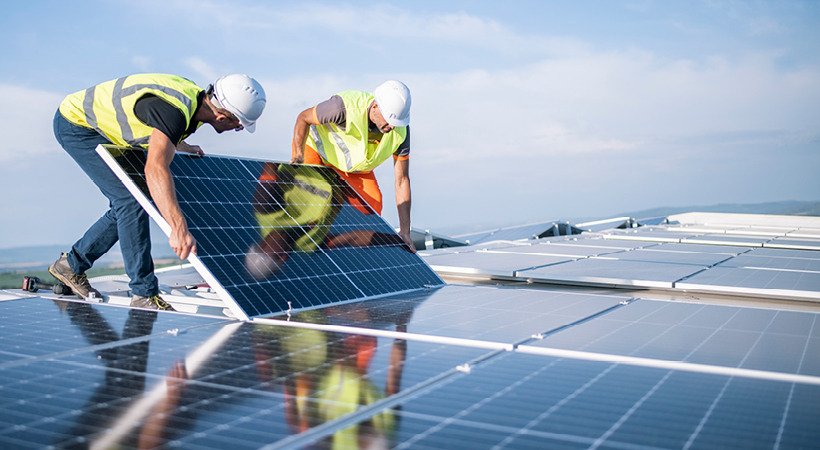Get Your Commercial Roofs Solar Ready: 3 Things to Consider
The drive for energy-efficient buildings comes with updated energy codes and, depending on your alternative power source, potential risks.
Because there are incentives like tax breaks for residential and commercial building owners laid out in the Inflation Reduction Act (IRA), it makes sense to consider adding renewable energy like solar electricity to new construction. The solar investment tax credit for qualified solar systems is worth 30 percent of total project costs until 2033.1 The Solar Energy Industries Association (SEIA) projects the commercial solar sector to grow an average of 8% over the next five years.2
Rooftops can make an ideal location for solar panels, as you can take advantage of underutilized real estate. But building owners, architects and contractors should be aware of what a solar-ready home or commercial building truly needs. Three things to consider before you invest in your roof’s solar future are the risk of fire, rooftop durability and the projected lifespan of your roofing system.
“Not all roofs are created equal, and if not properly outfitted, a commercial roof may not work well for a photovoltaic installation.”
– An excerpt by Jim Schneider, LEED AP, for Retrofit Magazine

1. Pay Attention to the Fire Risk
Because photovoltaic (PV) panels generate electricity, they come with an inherent risk of starting a fire. Design flaws, component defects and faulty installation can cause arcs between conductors or the ground, which can ignite nearby flammable material.3 Although rooftop fires caused by improper solar installations are uncommon,2 it’s worth mitigating the risk to protect the occupants and contents of a commercial building. Moreover, fire-related codes for roof-mounted solar energy systems are being updated. A reroof could be required if noncombustible materials weren’t initially used.
One way to prepare a solar roof is to include a gypsum-based cover board in your roofing system as a fire-resistant barrier. DensDeck® Roof Boards are noncombustible per ASTM E136, so they won’t burn. Their gypsum core and fiberglass mat facers help slow the spread of flames and smoke in the event of a fire.

2. Make Sure Your Substrate Is Durable and Consistent
The installation of a solar system, along with regular inspections, can increase the amount of foot traffic on your rooftop. Recurrent traffic is likely to occur in the aisles between electrical panels. There is also an added risk of punctures from dropped tools during maintenance. Specifying a durable, rigid substrate under your PV system can help protect against wear from the rise in rooftop activity and support the added weight of the panels themselves.
When designing a roof with solar panels, consider the potential wind loads that your building could endure. A consistent substrate with adequate compressive and flexural strength helps protect your roof from wind uplift. The right roof material can also absorb sound, which means occupants hear less noise from maintenance and outside events.

3. Know Your Roof’s Projected Lifespan
If your newly installed roof and its solar panels don’t have the same lifespan, they may require removal and reinstallation during a reroof. This not only costs your clients more in the long run—it can mean they stop trusting your roofing systems. That’s why solar-ready roofs should meet or exceed the life of your PV panels. This way everyone avoids unnecessary labor and costs down the line.
But here’s the silver lining: using a cover board can help extend the life of your roofs. In an FMI Roof Cover Board Survey completed in May 2020, 86% of single-ply roofs with a cover board met owner life expectancy compared to only 52% of roofs without a cover board. Adding this protective layer between the roofing membrane and the insulation can help your roof reach its maximum lifespan, ultimately contributing to a better return on investment.

“The future state of a roof can be a difficult discussion to have with the building owner, but it’s an important one. How do you value that asset over the lifetime of the roof—15 or 20 years? Are you going to add HVAC or solar to it? Are you in an area where you have increased negative weather patterns that are going to impact the roof? Applying long-term asset valuation is critical to deciding what roof system you should install on your building.”
– Greg Hudson, Director of Commercial Dens® Sales for Georgia-Pacific Gypsum
Overall, getting your roof “solar ready” means asking it to do more work. While some may consider solar development in the U.S. to be in its infancy, roofing contractors know from experience that solar panels add stress to roofing systems.
Combat this by using a high-quality, gypsum-based cover board to add strength to your roofs. Make sure to check out all the benefits of DensDeck® Roof Boards, then find out more about increasing your commercial roof’s ROI.
1. https://www.energy.gov/eere/solar/homeowners-guide-federal-tax-credit-solar-photovoltaics
2. https://www.trinasolar.com/us/resources/blog/c-and-i-top-trends-of-2024#:~:text=A%20Snapshot%20of%20C%26I%20Solar,will%20likely%20experience%20increased%20development
3. https://www.energy.gov/eere/solar/consumers-guide-fire-safety-solar-systems